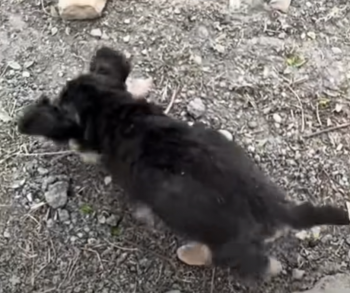The work of animal rescue is often marked by deeply emotional and poignant experiences, particularly when it involves encountering young puppies left to fend for themselves in harsh environments. These moments starkly illuminate the grim realities faced by countless animals and underscore the vital importance of rescue operations. Observing a vulnerable, defenseless puppy navigating life alone not only evokes a profound sense of heartbreak but also a resolute determination to intervene. It’s a vivid reminder of why rescuers are so crucial in giving these animals a much-needed second chance at life.

One chilly morning, a scene that tugged at the heartstrings unfolded on a busy highway. A tiny puppy, his body thin and fragile, staggered along the roadside, his movements slow and uncertain. His eyes, filled with a mix of fear and hope, scanned the passing cars, searching for a savior among the indifferent traffic.
Fortunately, fate intervened when a group of animal rescuers, returning from a nearby mission, spotted the pitiful sight. They pulled over immediately, their hearts heavy at the sight of such desperation. As they approached, it was clear the puppy was in dire straits. Despite his youth, barely a few weeks old, he bore the burdens of neglect—his coat matted and dirty, his body visibly malnourished.
The rescuers spoke softly, trying to soothe the frightened puppy, who, despite his initial trepidation, seemed to recognize the potential for help. He slowly inched toward them, his small tail wagging tentatively. The rescuers used this opportunity to gently scoop him up, wrapping him in a warm blanket, and quickly transported him to a veterinary clinic for immediate care.

The veterinarian’s assessment was grim but hopeful. The puppy suffered from dehydration and a mild fever, likely complications from malnutrition and exposure. He also displayed symptoms of an intestinal infection, possibly from ingesting contaminated substances in a desperate attempt to find food. The vet administered immediate treatment, including IV fluids and antibiotics, and outlined a recovery plan that included a nutritious diet tailored to help him regain strength and health.
Back at the rescuer’s home, the puppy, now named “Milo,” began his journey to recovery. His foster caretaker, one of the rescuers who had helped save him, was diligent in following the vet’s instructions. Milo was introduced to a calm environment where he could rest and gradually began to interact with other friendly pets in the home.

Over the following weeks, Milo showed remarkable progress. His energy levels increased, and his curious nature began to emerge as he explored his new surroundings with increasing confidence. The once timid and frail puppy was transforming into a lively and affectionate companion.
Recognizing the importance of socialization, Milo’s caretaker arranged playdates with other dogs, helping him learn to socialize and play. These interactions were crucial in building his confidence and preparing him for a potential future in a forever home.

Milo’s story reached a heartwarming milestone when, fully recovered, he accompanied his foster family and their pets on a beach outing. There, Milo frolicked in the sand, chased waves, and enjoyed the company of his new canine friends, a stark contrast to the lonely figure once seen on the highway.
This poignant rescue story underscores the transformative impact of compassion and action in the world of animal welfare. Milo’s journey from a vulnerable highway wanderer to a joyful, thriving puppy highlights the life-changing work done by rescuers daily. While his future, whether in his current home or with an adoptive family, remains open, Milo’s tale is a testament to the power of hope and the promise of a new beginning for rescued animals.
Click the video below to watch this incredible story!
Please ‘SHARE’ to pass on this story to a friend or family member
 Toledo, United States.
Toledo, United States.